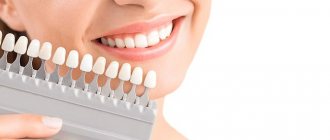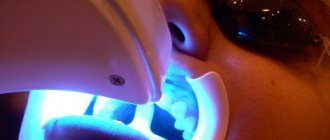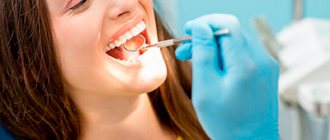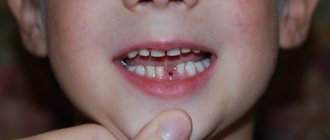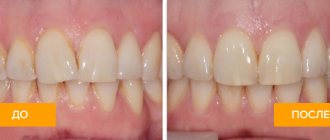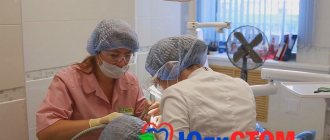Why do stains appear on teeth: the main reasons
The initial form of caries can be provoked by various factors, but most often this happens due to the formation of an acid-base imbalance in the oral cavity. A large number of harmful microorganisms constantly live in the mouth, which actively participate in the process of food decomposition. Food particles tend to remain between the teeth and on their surface, which leads to the destruction of tooth enamel.
Other reasons leading to the destruction of the structure of the enamel layer on the teeth include:
- incomplete or poor oral hygiene. After some time, failure to comply with hygiene rules leads to the appearance of white plaque on the teeth, which acts as an excellent environment for the accumulation of pathogenic bacteria. As a result, microorganisms produce harmful acids, which negatively affects the condition of tooth enamel. This process can be prevented by regular oral hygiene procedures. If, nevertheless, destruction of the enamel is observed, then treatment of caries at the spot stage will help prevent complications;
- hereditary predisposition. Even at the moment of conception and during intrauterine development, the structure and strength of tooth enamel is laid in the baby. When the mother’s body during this period lacks fluoride, calcium, vital vitamins and minerals, the risks that the child’s teeth will be excessively fragile and prone to the formation of carious processes are maximum;
- poor nutrition. Tooth enamel will be hard and durable if the daily diet contains foods high in calcium, fluorine and phosphorus (fish, cheese, cottage cheese, nuts, milk). But foods containing a large amount of carbohydrates (sweets, baked goods) must be kept to a minimum. This will protect the enamel from premature destruction;
- changes in the composition of saliva and its increased viscosity. Along with the fact that saliva is involved in the process of softening the food consumed, it also cleanses the surface of the teeth from food debris. When, due to changes in the structure of saliva, its acidity increases, a constant destructive effect on the teeth is formed. This process leads to the development of carious pathologies.
Often the initial form of caries appears in the area of the neck of the tooth, which is difficult to clean with a toothbrush. Regular examination of the condition of the teeth by a dentist and, if necessary, professional cleaning will help prevent the development of carious processes.
Why do stains appear on enamel?
Pigmentation, whitish areas on milk and permanent teeth occur in 40% of children. Some babies have barely noticeable dark dots and streaks, while others have spots reaching more than 5 mm. White spots on a child’s teeth do not stand out against wet enamel, so parents do not always notice them. Only after drying the teeth do the defects become clearly visible.
The main reason for the appearance of yellowish and whitish areas on teeth is enamel hypoplasia. This is a defect caused by a violation of metabolic processes during the formation and mineralization of teeth. Adverse factors can affect tooth germs at the stage of intrauterine development and up to 6–8 years. Diseases during pregnancy of the expectant mother lead to underdevelopment of the enamel of the mammary units. Hypoplasia of permanent teeth is preceded by disturbances in mineral metabolism in a child.
The location of areas with underdeveloped enamel depends on the age at which the baby suffered the disease. Spots on the front teeth of children appear due to diseases suffered from 5 to 9 months of life. During this period, incisors and fangs are formed. The timing of tooth formation is not the same, the spots are at different levels. With a long-term disease and significant metabolic disturbances, areas of hypoplasia are located throughout the crown.
The depth of enamel changes depends on the severity of the disease. Chalky stains on teeth are a mild degree of hypoplasia caused by minor short-term diseases. Smooth glossy spots do not cause painful discomfort. Severe pathologies lead to profound changes in the enamel. Teeth erupt brown, with areas of exposed dentin and erosion of the enamel layer.
If dark spots appear on your child’s teeth, sign up for a consultation at our Family Dentist clinic. We will establish the correct diagnosis and choose an effective treatment method.
Stages of caries spots
Dentists distinguish several stages of damage to one or more teeth by caries. Each stage is characterized by certain features, differences and symptoms.
Caries in the white spot stage
During the initial stage of caries, a person does not experience any discomfort and does not feel pain. The pathogenic process can be identified only by the white spots formed on the surface of the teeth. Although at first glance the tooth seems absolutely healthy, when stains appear in it, the process of destruction of structural tissues already occurs.
The spots that appear on the enamel in the initial stage have a whitish tint and are small in size, so upon visual inspection they are practically invisible. Only a professional specialist is able to identify the onset of pathogenic destruction of tooth enamel and promptly treat caries in the stain stage.
If you ignore treatment, then over time the light spot fades, tooth enamel loses its natural shine, becomes fragile and loose, and the carious process progresses more and more.
Important! If you identify the development of the initial form of caries, which manifests itself as microscopic specks, then you can avoid serious dental treatment. Therefore, every person should visit the dentist at least 2 times a year for a preventive examination of the oral cavity and, in particular, the condition of the teeth.
Black spot on teeth
If you ignore the appearance of white spots, then caries gradually passes into the next stage of a dark spot. This form is more serious and dangerous in comparison with the previous one.
Demineralized tissues grow very quickly, the white spots become darker and more visible. The white shade turns into brown or brown due to pathogenic bacteria entering the porous structure of the enamel.
Pathogenic microorganisms increasingly destroy the tooth surface and the disease moves into the next stage - superficial caries, the treatment of which is longer and more complex.
pink tooth
It happens that a previously treated tooth, which does not hurt at all and does not cause any discomfort, begins to acquire a pink, burgundy, brown-red color over time. Most likely, this tooth was previously treated for complicated caries (pulpitis or periodontitis), when the pulp (nerve) was removed and the root canals were subsequently filled with resorcinol-formalin paste. The method of resorcinol-formalin root canal filling was proposed by Dr. Albrecht back in 1912. This method of treating complicated caries was based on the mummifying and bactericidal properties of a mixture of resorcinol and formaldehyde, which stopped the decay of partially removed pulp.
Resorcinol-formalin paste hardens very slowly in the canals and, as previously thought, seals them. This method was inexpensive and therefore became widespread. In Soviet times, it was actively used, and in our time it can still be used mainly for filling chewing teeth, where the pink color of the tooth does not violate the aesthetics.
However, many years of research have shown that the resorcinol-formaldehyde method is hazardous to health. Formalin contained in the paste has mutagenic and carcinogenic properties. It can penetrate from the tooth into other organs of the body; traces of formaldehyde are found in the liver, kidneys, lungs, and muscle tissue. Therefore, progressive doctors do not use resorcinol-formalin paste in their practice. For a dozen or more years, the patient may not feel any discomfort in a tooth treated with this method, but the inflammatory process continues, albeit very slowly. Cysts form on the roots, between the roots.
The toxic effect of the paste also has a bad effect on the gums - it detaches from the tooth, gingival and periodontal pockets are formed, where plaque and food debris accumulate, which provokes inflammation of the tissues surrounding the tooth. In most cases, this all leads to repeated endodontic treatment or even tooth extraction, which is associated with a number of difficulties. On an x-ray, the root canals after the resorcinol-formalin method look empty, and this makes diagnosis difficult. A tooth soaked in formaldehyde becomes very fragile and crumbles badly. The paste in the channels becomes hard and transparent, like glass. It is highly undesirable to use “pink” teeth in orthopedic structures.
In Russia, the dental association proposes to exclude this method of canal filling from the curriculum of dental faculties, but it still continues to be used. The resorcinol-formalin method is very cheap and takes much less dentist time compared to modern endodontic treatment methods.
Visit the dentistry on Ilyich Square "City Denta"
Caries in the spot stage: diagnostic measures
The most reliable and effective diagnostic procedure for the initial form of caries is to check the integrity of tooth enamel using special organic dyes. Dentists use:
- carmine;
- tropeolin;
- methylene red;
- methylene blue.
The latter is more often used in dental practice. First, the specialist removes accumulated plaque from the tooth surface. Use cotton swabs to isolate the tooth from saliva and then apply the coloring solution. After a few minutes, the solution is thoroughly washed off and the condition of the enamel is analyzed. If it is stained, this indicates the presence of caries.
There are other ways to diagnose caries in the spot stage:
- drying of enamel. The surface of the tooth is treated with a solution of hydrogen peroxide, then the enamel is thoroughly dried with a stream of warm air. After drying, areas with white spots will immediately become noticeable;
- radiography. The area affected by caries appears as a small spot on an x-ray. The method is used mainly for contract caries;
- examination with a stomatoscope. First, all accumulated plaque is removed from the surface of the teeth, then the dentition is illuminated with the device. Under ultraviolet radiation, it is not only easy to distinguish damaged tissue from healthy tissue, but it is also possible to determine the boundaries of pathology.
In order to treat caries in the spot stage, it is very important to undergo a timely diagnosis, accurately recognize the presence of pathology and exclude similar diseases that resemble caries.
Treatment methods for caries in the spot stage
Since the main cause of stains is demineralization of the enamel, treatment of caries at an early stage is carried out using a conservative method without the need to drill the tooth.
Professional treatment of initial caries
After diagnosing caries in the stain stage, it is very important to carry out adequate treatment and prevent complete tooth destruction. At an appointment with a specialist, treatment of caries in the spot stage can be carried out in different ways:
- remineralization;
- Borovsky-Leus method;
- gel applications;
- fluoridation.
The essence of the treatment is to saturate the damaged areas with calcium and fluoride using special professional preparations.
In general, the treatment process in the dentist’s office is carried out in the following order:
- professional teeth cleaning to remove plaque and stones;
- washing and drying;
- application of specialized preparations depending on the chosen method;
- consultations on further dental care;
- monitoring the further condition of the teeth;
- preventive actions.
After treatment for “white caries,” you should contact your dentist no later than 2-3 months. The specialist will evaluate the effectiveness of treatment and the quality of the patient’s oral hygiene.
Treating white spots at home
Not only in the dental clinic is treatment of caries in the spot stage carried out; a course of therapy is also possible at home. Just first you need to consult a dentist and, if necessary, have your teeth professionally cleaned.
For home treatment you can use:
- remineralizing gel, for example, ROCS Medical Mineral. The composition is enriched with magnesium, calcium and other microelements that penetrate tooth enamel, remove stains and restore its natural shine;
- special toothpastes with a healing effect. ROCS Medical and Elmex cope well with such problems;
- fluoride gel remineralizes white spots and prevents the destruction of the enamel coating of teeth.
Along with professional remedies at home, you can also use traditional medicine recipes:
- Finely chop the pumpkin tail. Pour boiling water and leave for an hour. Rinse your mouth with the solution several times a day;
- Chew a piece of dried calamus daily for 5-7 minutes. The number of days depends on the size of the spot.
Both in the case of medications and folk remedies, treatment of caries in the spot stage is aimed at enriching the enamel with useful elements and minerals.
Case 4. The source of inflammation at the root of the tooth - the so-called. cyst
Imagine the situation.
A tooth that previously did not have a filling or was previously treated endodontically begins to hurt. An examination is carried out, X-ray control is done, but often a more informative cone-beam computed tomography CBCT or, as many say, a 3D x-ray is performed. A dental cyst is detected. The doctor recommends removing the tooth because there is a large area of inflammation at the top of the tooth root, caused by an infection in the root canal. The infection gets beyond the root tip and causes inflammation. This inflammation can be treated by removing the infection from the root canal. It is easier for a doctor who does not have the knowledge and treatment methods to remove a tooth.
How to do it right:
There is no need to remove the tooth. In the case of a dental cyst, it is necessary to carry out diagnostics, examination and high-quality treatment under the control of an operating microscope with isolation of the working field, followed by hermetically sealed restoration of the tooth at the stage of endodontic treatment. The recommendation is simple:
before removing a tooth, consult a professional. You may not need tooth extraction! This means that sinus lifting, implantation and prosthetics procedures following the removal will not be necessary.
Preventive measures for “white caries”
The main component of dental health and prevention of caries development is compliance with the rules of prevention:
regular and proper oral hygiene. It is necessary to brush your teeth not only with a brush, but also after each meal you should use dental floss. After removing pieces of food with a thread, it is advisable to chew chewing gum for 5 minutes;
- Maintain a nutritious diet and try to avoid frequent snacks between meals. A common cause of caries is frequent consumption of sweets, flour, candies, chips, fast foods, and carbonated drinks. For dental health, the diet should contain fish, vegetables, fruits, kefir, nuts, cottage cheese, milk and other products with a high content of fluorine, phosphorus and calcium;
- periodically carry out professional teeth cleaning and treat the enamel with fluoride-containing preparations.
If you follow these basic rules, you can keep your teeth strong and healthy. But in order to avoid complications and prevent the pathology from becoming severe, you need to regularly visit the dentist and, if necessary, carry out proper and effective treatment of caries in the spot stage.
Why does the eyeball of one or both eyes hurt: reasons
Keep in mind! There are many causes of pain in one or both eyeballs, and they all have their own characteristics and prerequisites. The most common of them are:
- Muscle fatigue . This problem is mainly typical for people who work at a computer for many hours every day. But this is not only a problem of the 21st century: people have had such symptoms since books appeared. Since reading in poor lighting, lying down or for a long time also leads to fatigue.
- Colds and flu . With such ailments, people often feel aching pain in the organs of vision. This is explained by the fact that pathogenic microorganisms that enter the body spread to many organs, including the eyes, which hurt due to inflammation. Also, pain in such diseases is explained by an increase in intraocular pressure, which is always observed with infectious lesions of eye tissue.
- Infectious lesions of the nasal sinuses. In this case, pathogenic microorganisms also penetrate into the organs of vision. In this case, the most pain appears in the back of the eye, since in these areas the concentration of nerve endings is higher.
- Traumatic syndrome . This is an obvious cause of painful sensations that arise due to a violation of the integrity of the outer covering of the eyeball and damage to the sensory receptors.
- Lesions of the blood vessels of the eye . In this case, the receptors signal about inflammatory processes in the vascular system or an increase in IOP that occurs due to vascular pathologies.
- Ocular herpes . In fact, this disease, which is also known as shingles, is not an ophthalmic disease. But in some cases, herpes also spreads to the area of the visual organs, and at the same time there are attacks of severe sharp pain that does not go away for a long time. The pathology requires immediate treatment in a hospital setting, otherwise complete loss of vision is possible.
- Dry eye syndrome. It is characterized by infrequent but periodic cutting pains that arise from muscle overstrain when concentrating for a long time on the image of a computer monitor. Such pain goes away if you normalize your work at the computer and take breaks every hour, distracted by extraneous matters.
- Iridocyclitis. This inflammation of the iris is characterized not only by pain, but also by increased photophobia. In such cases, it is necessary to treat the disease, since pain relief is impossible.
- Infectious pathogens that enter the eyeballs from other organs. In this case, the causes of pain can be chronic sinusitis, recurrent herpes, tonsillitis, and even caries and even urogenital infections.
- Prolonged or improper use of contact lenses and sleeping in lenses not intended for night use.
- General disorders in the circulatory system , in which small capillaries in the eyeballs are destroyed. Such pathologies require drug therapy, which includes taking vascular-strengthening drugs.


